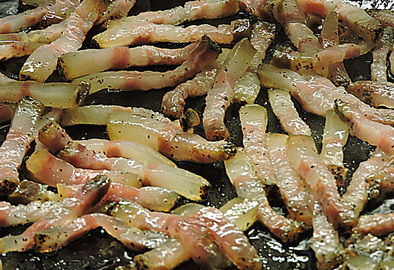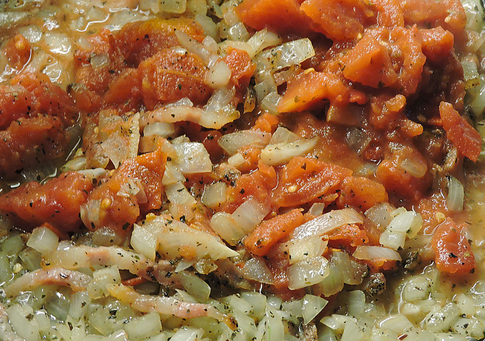|
Before the earthquake, the town of Amatrice (pronounced am-ah-TREE-chay) in the Lazio region of northern Italy, was known for many things... the wonderful mountain setting, suited for fishing and trekking in summer, and for skiing in the winter. The town itself was a beautiful, quaint medieval village, complete with many frescoes in its churches, a famous rose window and of course, its campanile with its huge bell. But there was one thing the town was even more famous for: the gastronomic treasure called Spaghetti Amatriciana. As you may know, most of the town was destroyed in the quake. Many lives were lost. But for certain, one tradition lives on and may be the thing that helps the village rise from the ashes. Spaghetti Amatriciana has been made since the 18th century, and more than likely, its history goes back much further than that. Restaurants all over the world have been offering the dish with proceeds going to aide the people and commune of Amatrice. Spaghetti Amatriciana was originally a peasant recipe, created by poor shepherds who used one of the cheapest--often discarded--parts of the pig, namely guanciale (or pig jowls). Similar to bacon, guanciale has more fat and little or no salt or smoke flavor. The addition of tomatoes, onions and white wine complete the recipe. One can understand why such a fatty part of the hog got to be a favorite in the mountainous region--fat helps keep the body warm. Today, the sauce has several variants. Gricia, is a simple sauce similar to Amatriciana also using guanciale, with pecorino (sheep) cheese and black pepper, but no tomatoes. This might actually be the earliest predecessor of Amatriciana, possibly dating back before tomatoes were brought back from the New World. The ingredients are simple and easily carried in a shepherd's pack. Then there is Bucatini 'Matriciana (in Roman dialect) which came to Rome in the 1800s and today is considered to be a classic of Roman cuisine, even though the dish came from Amatrice. Finally, and perhaps most famous of this family of sauces is Spaghetti alla Carbonara, a Roman dish using eggs and either Pecorino Romano or Parmigiano-Reggiano to make a creamy sauce, with black pepper and some sort of bacon added (either guanciale, pancetta or at times, prosciutto). I felt compelled to make an authentic version of Spaghetti Amatriciana in remembrance of the souls lost in Amatrice... I did Google searches in Italian to ensure I would find traditional, local recipes. I then set out to make it for Lisa and Lucas... Ingredients 1 pound of spaghetti 3 ounces of guanciale (if you can't find it, substitute pancetta) 1 small onion, diced 16 ounces of diced tomatoes (use fresh if you have access to sweet tomatoes) 1-1/2 cups white wine (to keep it regional, use wine made with the Trebbiano grape) 1/2 cup grated Pecorino-Romano Directions
Serve with some nice crunchy bread cut into small slices for use as a scarpetta. (Read about using a scarpetta HERE) and a nice glass of white wine. I'm going to be honest, here. When I was a boy, my Dad used to love fatty things. He would eat the thick, white fat off the sides of his steaks. I've never developed a taste for eating fat. I never liked the greasy texture of the stuff. My bacon has to be crispy. I prefer a drier prosciutto. I like my bacon crispy. Although the flavors of our Spaghetti Amatriciana were pretty good, none of us really enjoyed the gelatinous texture of the guanciale itself. The striations of actual pork meat were cooked well, but had a dryness and lack of flavor that matched the bits of pork in the pork-fried rice we order from our local Chinese take-out. The fatty parts were--well, just plain fatty. The dish itself wasn't really greasy (I had removed most of the rendered fat from the pan), but it did have a lard-like flavor I didn't enjoy. If I wanted to make this dish again, I might modify it to our family's tastes... perhaps not using a raw type of bacon (I do realize that technically, guanciale is not a "bacon"), but instead using a thick cut smoked bacon, like prosciutto. Or, as a fussier solution, I would cut the meaty parts of the guanciale out to add them and saute them later on, only after the fattier parts have gone crispy, like I prefer American style bacon. I hope no one thinks I'm disrespecting the original Spaghetti Amatriciana recipe. I love authentic recipes and regional products. But I'll be the first to admit it, when exploring the culinary world often I find my taste palette is not as broad as I would hope it to be. Still, I loved making this dish in honor of Amatrice and its inhabitants (and those in neighboring communes) have--and are--going through. Before partaking in our meal, we had a moment of silence on behalf of the lost lives. With so much attention paid to their wonderful town, I am certain that in time, they will rebuild, stone by stone, as I have seen on other towns in Europe after such disasters. So, try your own tribute with this recipe, or a variation or by making one of it's "cousin" dishes. And don't forget to make a donation to help them rebuild. Pray for Amatrice. --Jerry Finzi
0 Comments
Your comment will be posted after it is approved.
Leave a Reply. |
Categories
All
Archive
June 2024
|






 RSS Feed
RSS Feed
